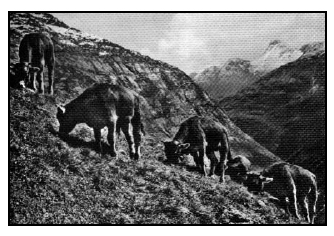BSCBA - USA 1869-1879
"In The Beginning"
Editor's Note: The Brown Swiss Cattle Breeders' Association of the USA celebrated its 125th Anniversary in 2005. To commemorate the history of the Brown Swiss breed in the USA and the 125 years of the Association, each month a review of its history was published in the Bulletin covering a 10-year period. This first review covered an 11-year period and the time from the first imports into the US up to the organization of the Association in 1880.
The Brown Swiss breed is one of the oldest of the dairy breeds in the world. It is descended from cattle used in the valleys and mountain slopes of Switzerland since before historic records began. It was here that certain breed characteristics became so firmly established that they are still evident to this day. The origins still farther back are somewhat doubtful. Some think that the breed goes back eventually to Oriental origins, having been introduced into Central Europe from the steppes and valleys of Western Asia. On the other hand, cattle bones found in the ruins of the Swiss Lake Dwellers are very similar to the bones of present-day Brown Swiss cattle. Such evidence indicates that a type of cattle apparently closely related to Brown Swiss of today existed during the Bronze Age in the area now known as Switzerland.
The Swiss nation is made up of twenty-two cantons (similar to our states). From remote time, the Canton of Schwyz had the reputation of possessing the best Brown Cattle, and thus the name Schwyz cattle, or Brown Swiss as known in America, was derived.
Swiss cattle were grazed throughout the summer at 3,000 to 8,500 feet above sea level. The unusual physical exertions and high altitude under which generation after generation of these cattle were developed has played an important part in the selection for strength and ruggedness as found in the Brown Swiss breed today.
The first recorded Brown Swiss cattle to be introduced into American were brought in by Henry M. Clark of Belmont, Massachusetts, in the winter of 1869 and 1870. This first importation consisted of one bull and seven pregnant females. The bull, William Tell, is the Number 1 bull listed in the Brown Swiss Record, and the seven females, Zurich, Lucerne, Gretchen, Brinlie, Lissa, Christine, and Geneva, are the first seven females listed therein. All eight of these animals came from the Canton of Schwyz, Switzerland. This first shipment also included Albert Tell, imported in dam Zurich No. 1 and recorded as No. 2 bull in the Brown Swiss Record, and also a female, Verona, imported in dam Brinlie No. 4 and recorded as female No. 8.
From this first importation made by Clark, there were 251 descendants recorded before the next importation of 10 head (one bull and nine females) was made in 1882 by Messrs. George W. Harris of Wethersfield, Connecticut, and Nelson B. Scott of Worcester, Massachusetts.